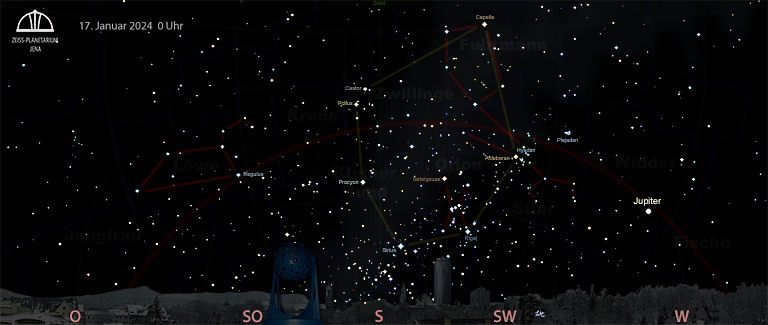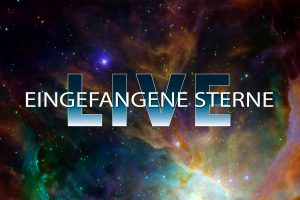Bis zum Monatsende verlängert sich der helle Tag um fast eineinhalb Stunden gegenüber dem Winteranfang. Die Sonne bewegt sich in diesem Monat vor dem Tierkreissternbild Schütze und ab 20. vor dem Steinbock. Am 3. zieht die Erde durch den sonnennächsten Punkt ihrer jährlichen Bahn.
Neumond ist am 11. Januar, Vollmond am 25.
Am frühen Abend können wir knapp über dem Horizont in südwestlicher Richtung noch den Ringplanet Saturn vor dem Tierkreissternbild Wassermann und hoch im Süden den Riesenplanet Jupiter vor dem Tierkreissternbild Widder sehen.
Am westlichen Nachthimmel zeigen sich die Sterne des Herbstvierecks und der Sternkette aus Pegasus und Andromeda. Den Südhimmel dominieren die hellen Sterne des Wintersechsecks. Besonders auffällig ist das Sternbild Orion mit dem rötlichen Schulterstern Beteigeuze und dem weiß-bläulichen Fußstern Rigel. Die drei Gürtelsterne des Orions weisen in der Verlängerung nach rechts oben zum Aldebaran im Sternbild Stier, nach links unten zum hellsten Stern am irdischen Himmel, Sirius im Sternbild Großer Hund. Darüber schließen Prokyon im Kleinen Hund, die Zwillinge Kastor und Pollux sowie Kapella im Fuhrmann das Wintersechseck.
In der zweiten Nachthälfte funkeln die Sterne im Trapez des Löwen, Regulus führt das Frühlingsdreieck an.
Venus ist weiterhin am Morgen im Südosten zu sehen. Vom 3. bis 19. Januar zeigt sich der sonnennächste Planet Merkur am südöstlichen Horizont.
W. Don Eck
Zeiss-Planetarium Jena
Sun, moon, planets and stars in January 2024
By the end of the month, the light day will be almost an hour and a half longer than at the beginning of winter. The sun moves in front of the zodiacal constellation Sagittarius this month and in front of Capricorn from the 20th. On the 3rd, the Earth passes through the closest point to the sun in its annual orbit.
New moon is on 11 January, full moon on 25 January.
In the early evening, we can still see the ringed planet Saturn just above the horizon in a south-westerly direction in front of the zodiacal constellation Aquarius and the giant planet Jupiter high in the south in front of the zodiacal constellation Aries.
In the western night sky, the stars of the autumn quadrilateral and the star chain of Pegasus and Andromeda can be seen. The southern sky is dominated by the bright stars of the winter hexagon. The constellation Orion is particularly striking with the reddish shoulder star Betelgeuse and the white-bluish foot star Rigel. The three belt stars of Orion point upwards to the right towards Aldebaran in the constellation Taurus and downwards to the left towards the brightest star in the terrestrial sky, Sirius in the constellation of the Great Dog. Above it, Prokyon in the Little Dog, the twins Castor and Pollux as well as Capella in the constellation Charioteer or Wagoner close the winter hexagon.
In the second half of the night, the stars twinkle in the Trapezium of Leo, Regulus leads the Spring Triangle.
Venus can still be seen in the south-east in the morning. From 3 to 19 January, Mercury, the planet closest to the sun, will be visible on the south-eastern horizon.


